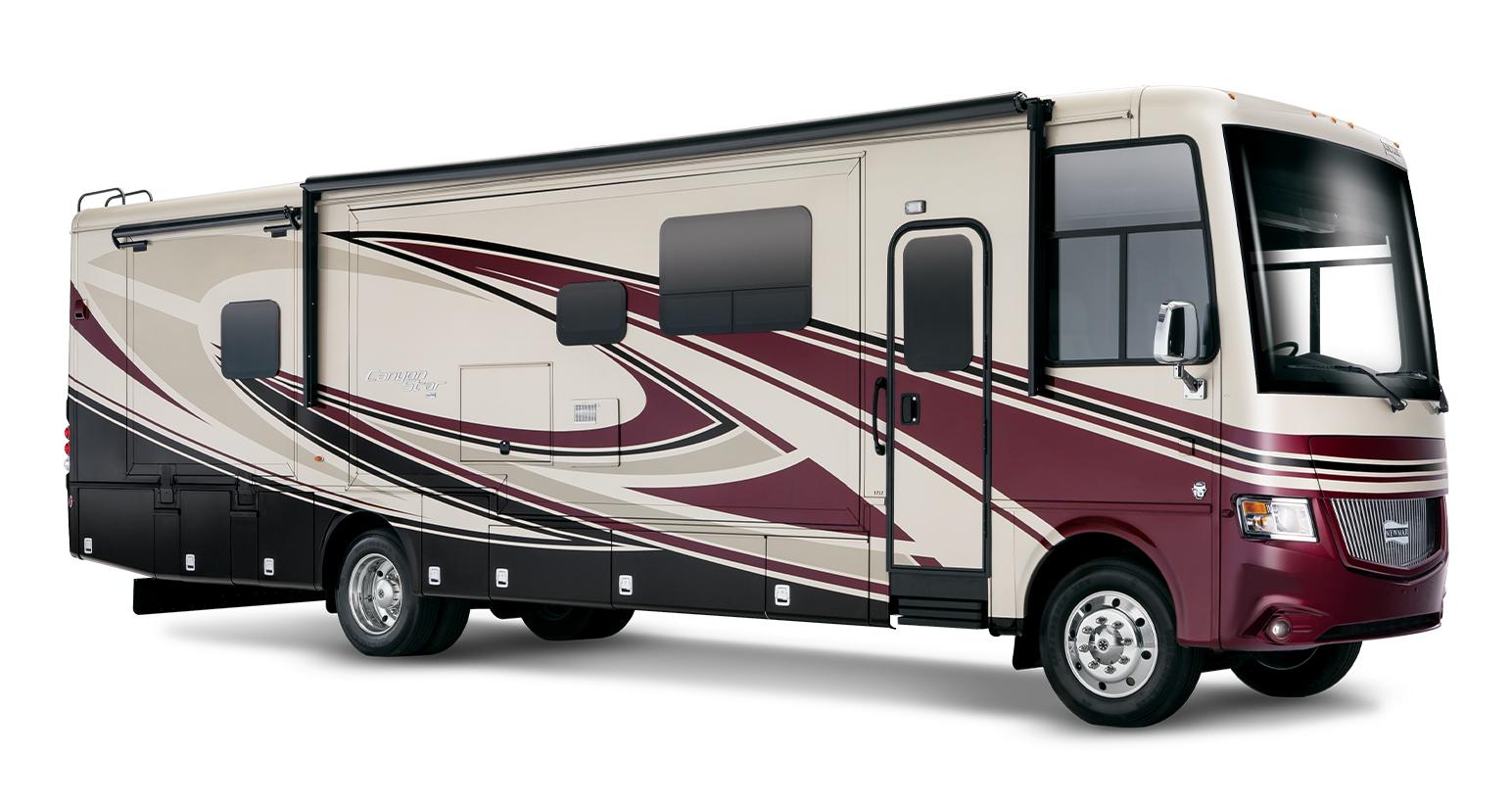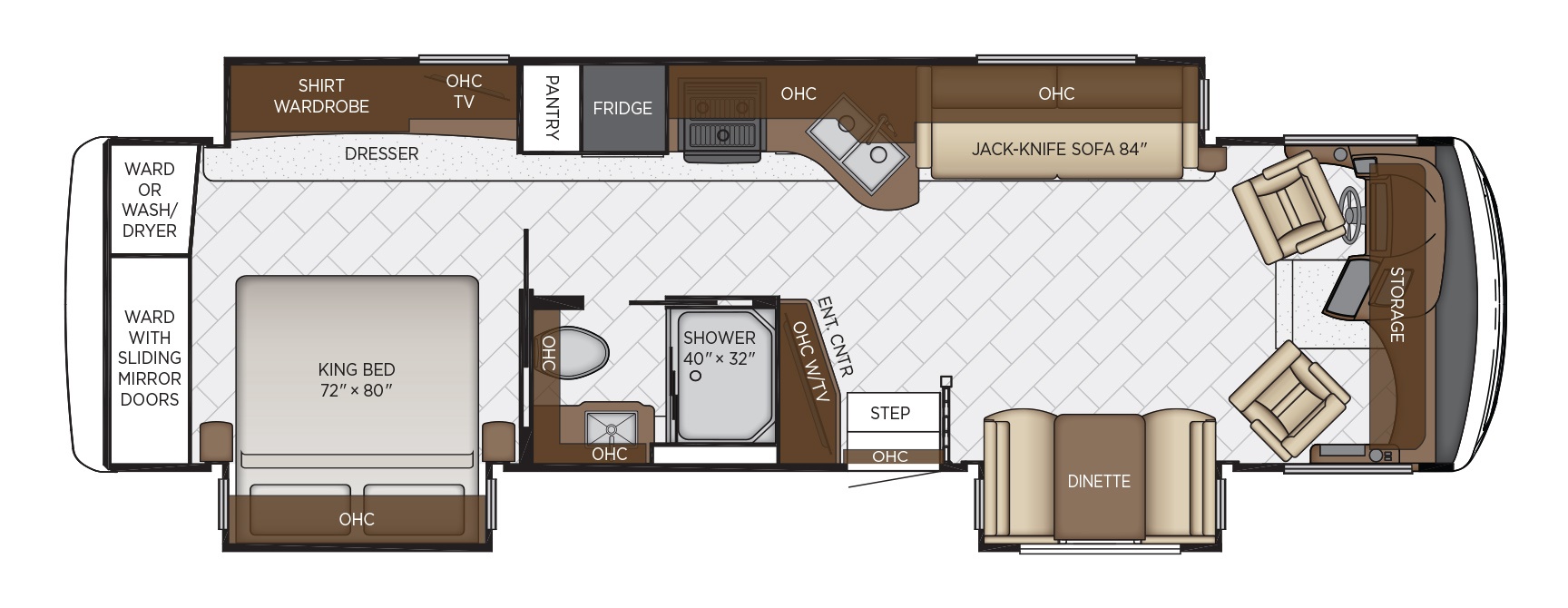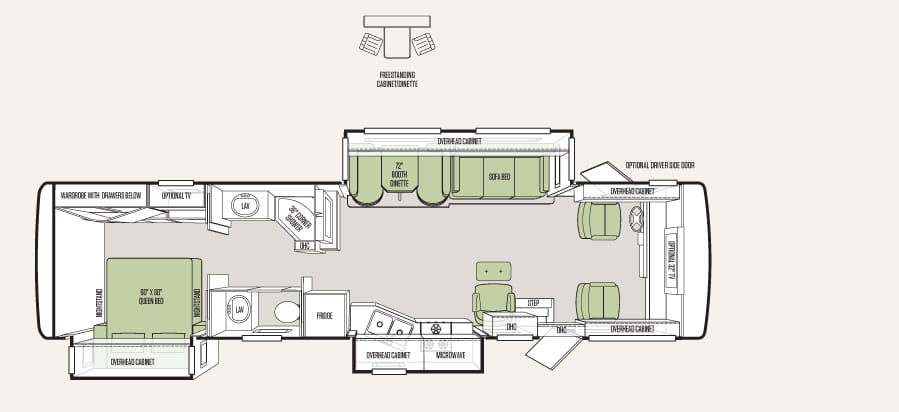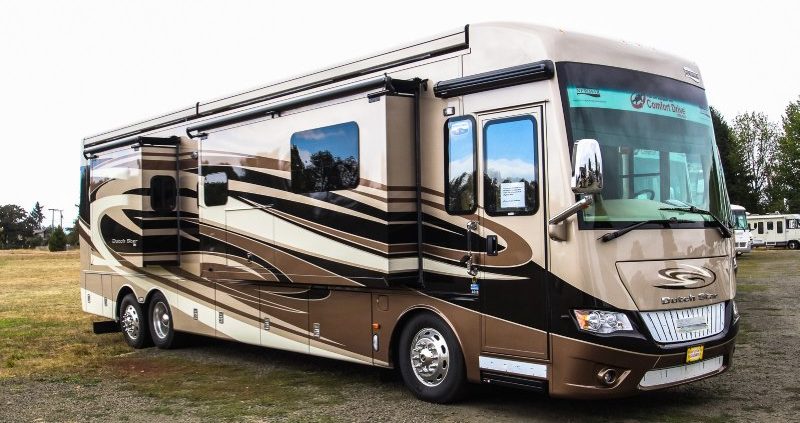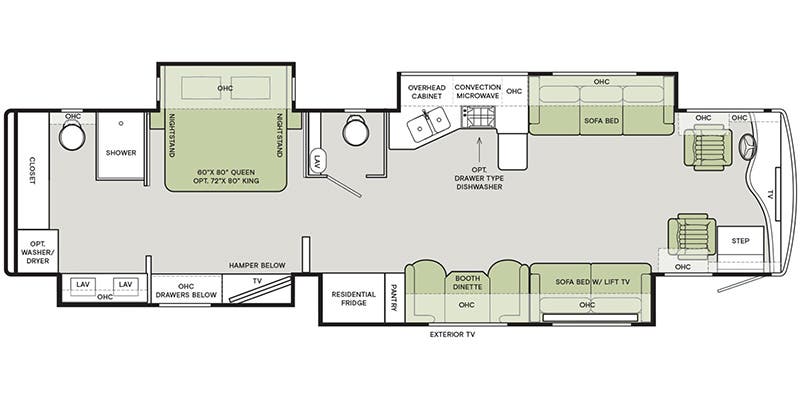Class A Motorhomes
This is a fairly large grouping of motorhomes with lots of options. These motorhomes can vary from 25 ft all the way up to 45 ft. Probably the biggest differentiator other than just length is source of power. Typically class A motorhomes are either diesel pushers, meaning they have a diesel engine mounted in the back or they are gas powered with a gas engine in the front. Having said that, there are some motorhomes that have a front mounted diesel engine, but they are not as common.
To many, the class A is the perfect motorhome for full time RV living as its size enables you to have more of the traditional amenities of a traditional home. Most class As have a separate shower, separate larger oven, wide screen tvs and even washer dryers. Luxury class As require little to no compromise on creature comforts and can be more upscale than many condos or apartments .
Mobility
LIke the class C and B motorhomes, one of the advantages of a class A motorhome is the turn the “key and go” aspect.
One of the distinct advantages of a class A over a fifth wheel trailer is that because most people tow a car behind their motorhome, they have a more economical and maneuverable form of transportation when they arrive at their destination. This is also a down side as it does not make it as easy to go each morning as you must hook up the car if you unhooked and explored the day before.
The class A motorhome is not as maneuverable as smaller motorhomes and care must be taken in terms of getting into fuel stations and RV parks.
Number of People
Class A motorhomes come in a wide variety of floor plans and accommodations. Some have a second small bedroom in the hall way area with bunk beds, for example. Most have a pull out couch in the living room to accommodate guests. Some are configured with a built in dinette which can accommodate 4 adults or more children and others have the pullout table with 4 chairs for dining.
Physical condition
Class A motorhomes, themselves do not require physical strength or agility but depending on if you tow a vehicle you would need both of these.
There are two ways of towing a vehicle, flat towing or using a trailer dolly. Both of these require some physical strength and agility.
I will be devoting a separate post to discussing the advantages and disadvantages of both of these towing methods, as we have had both.
For this discussion, it is important to note that you should not choose to trailer dolly your vehicle if you are not in fairly good physical condition. One needs physical strength and agility to use a trailer dolly. By the way, just for clarification, only certain vehicles can be “flat towed” meaning all 4 wheels on the ground.
Working while roaming
Working from a class A motorhome can be a real pleasure. Many come with built in work stations and if not, the dinette serves the purpose very well. Because the class A is so roomy it is relatively easy fo another person to do their own thing while one person works from home.
We will be devoting numerous blog posts in the future to such subjects as ”internet access on the road” and other work at home topics.
Terrain
Class A motorhomes are not the best choice for off-roading and exploring the less traveled roads.
Depending on the size, you may even have some difficulty going into National Parks. Keeping the size of your class A home under 35 ft is the best length for entry into these areas.
There are, however, areas that you can go to and still boon dock in a larger class A such as the BLM (Bureau of Land Management) areas in Quartzite Arizona, just to name one area. You can drive out in the desert on firm dirt roads and park for very low cost and boon dock. The class A with its larger holding tanks and generator is well suited for this type of boon docking.
I want to address the issue of power when it comes to mountainous terrain. There is always much debate by motorhome owners as to the advantages and disadvantages of gas vs diesel power. It is our opinion that if you are planning travel in mountainous areas, your best option is a diesel motorhome. We have had both, and have concluded that although a large gas motorhome will make it up the mountain, it maybe a nail-biting experience, incredibly slow and noisy.
Coming down the mountain cam be even more scary as gas motorhomes do not have exhaust brakes, an incredibly valuable feature which uses the engine gears and exhaust to effectively slow the vehicle as you descend. There is much, much more that can be said about this topic and likely other blog posts will explore this further. If you have more questions, don’t hesitate to write us. Click here to go to the “Contact Us” page.
Budget and construction
Class A motorhomes are the most expensive of all the motorhomes. They are usually built on custom chassis meant for motorhomes and can cost anywhere from just under a $100,000 to more than a million. They are not an investment by any means as they depreciate as a car would and as all RVS do. But they are an exciting lifestyle choice and for many of us, the lack of appreciation has been accepted as worth it.
Motorhomes vary greatly in quality of construction, plumbing, electrical components and fixtures and “furniture”. The list of things to look for when considering a new motorhome or used one is detailed in our discussion of trailers. Click here to go that that section of the blog.
In our opinion there are two higher level quality motorhome manufacturers Newmar and Tiffin. We have owned both and have extensively researched and looked at others. Both of these manufacturers produce a wide variety of gas and diesel models with may layouts to choose from. There is an even higher level of motorhome construction and quality but those are motorhomes built on Prevost shells, a well known bus manufacturer. These motorhomes routinely are priced more than a million dollars.
We will discuss the advantage and disadvantages of choosing a used motorhome vs a new motorhome in subsequent posts.
Level of comfort
Class A motorhomes can have an extraordinary level of comfort. As mentioned previously, they can have multiple TVs, washer and dryers, AC and central heat, large convection/microwave ovens, heated tile floors, ceramic tile showers, electric fire places and the list can go on and on! Depending on your budget and size of your selection the amenities and options are truly amazing.
Handiness
One’s handiness and being able to handle what may happen as your home experiences the continuous “earthquake” of going down the road is pretty much the same as those points made in the trailer discussion of this topic.
A class A motorhome is even more complicated than a trailer, in no small part do to the increase in number and quality of amenities and options as we discussed above. So there is even more opportunities for things to come loose, break, leak etc. I do want to add here that it has been my experience that the original quality of the construction, fixtures, furniture etc has direct bearing on how easy it will be to successfully address the issue ALL motorhomes and RVS regardless of the brand will have these issues but the higher the level of original quality the easier it will be to fix them.
Space
Most new class A motorhomes have considerably higher ceilings than older models and therefore impart a more roomy feeling. This same ceiling height, unlike a fifth wheel extends to all part of the coach as there is no “upstairs” in a motorhome.
With the advent of slides, the living areas in motorhomes have opened up even more. Many new motorhomes have 4 slides that oppose one another on each side of the coach. This creates a great feeling of openness and space. Many full timers feel this is essential for living in an RV full time.
Stuff
Class A motorhomes have considerable storage space both in side their cavernous interiors and outside in large bays that are built into the area between the floor of the RV and the underside of the vehicle above the road. The construction of a motorhome is very similar to a bus with very large bays outside for storage. Even RVers with hobbies having storage requirements should find the the average class A will work for them.
